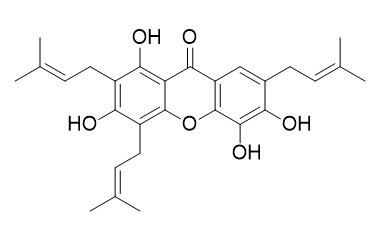Parvifolixanthone A
Parvifolixanthone A is a natural product from Garcinia parvifolia.
Inquire / Order:
manager@chemfaces.com
Technical Inquiries:
service@chemfaces.com
Tel:
+86-27-84237783
Fax:
+86-27-84254680
Address:
1 Building, No. 83, CheCheng Rd., Wuhan Economic and Technological Development Zone, Wuhan, Hubei 430056, PRC
Providing storage is as stated on the product vial and the vial is kept tightly sealed, the product can be stored for up to
24 months(2-8C).
Wherever possible, you should prepare and use solutions on the same day. However, if you need to make up stock solutions in advance, we recommend that you store the solution as aliquots in tightly sealed vials at -20C. Generally, these will be useable for up to two weeks. Before use, and prior to opening the vial we recommend that you allow your product to equilibrate to room temperature for at least 1 hour.
Need more advice on solubility, usage and handling? Please email to: service@chemfaces.com
The packaging of the product may have turned upside down during transportation, resulting in the natural compounds adhering to the neck or cap of the vial. take the vial out of its packaging and gently shake to let the compounds fall to the bottom of the vial. for liquid products, centrifuge at 200-500 RPM to gather the liquid at the bottom of the vial. try to avoid loss or contamination during handling.
Appl Biochem Biotechnol.2020, 190(2):732-744
Pharmaceuticals (Basel).2024, 17(3):341.
Current Analytical Chemistry2024, 20(8):599-610.
Nat Prod Sci.2018, 24(2):109-114
J Ethnopharmacol.2017, 198:87-90
Food and Fermentation Industries2018, 44(371)
Nutrients.2024, 16(16):2612.
Mol Pharm.2018, 15(8):3285-3296
Fitoterapia.2021, 153:104995.
Inflammation.2021, doi: 10.1007
Related and Featured Products
Chinese Traditional & Herbal Drugs, 2012, 43(3):436-439.
Chemical constituents from stem barks of Garcinia paucinervis.[Reference:
WebLink]
To study the chemical constituents from the stem barks of Garcinia paucinervis and their antitumor activities.
METHODS AND RESULTS:
Chemical constituents were isolated and purified from petroleum ether extract of G.paucinervis by chromatography on silica gel,RP-18,Sephadex LH-20 column,and preparative TLC.Their structures were identified on the basis of spectroscopic analysis and chemical evidence.The antitumor activity was screened by MTT assay. Ten compounds were isolated and identified as cambogin(1),pyromeconic acid(2),β-sitosterol(3),daucosterol(4),7-prenyljacareubin(5),Parvifolixanthone A(6),formoxanthone A(7),termicalcicolanone A(8),1,3,5,6-tetrahydroxy-4-prenylxanthone(9),and isogarcinol(10).Compounds 5 and 7 showed moderate cytotoxic activity against HL-60,SMMC-7721,A549,MCF-7,and SW480 cell lines.
CONCLUSIONS:
Compounds 2—5 and 7—10 are isolated from this plant for the first time and the13C-NMR spectroscopic data of compound 5 are firstly reported.
Tetrahedron, 2006, 62(36):8578-8585.
Phloroglucinols, depsidones and xanthones from the twigs of Garcinia parvifolia.[Reference:
WebLink]
METHODS AND RESULTS:
Seven phloroglucinols, named parvifoliols A–G (1–7), two depsidones, named parvifolidones A, B (8, 9), and three xanthones, named Parvifolixanthone A, parvifolixanthone B, parvifolixanthone C (10–12), were isolated from the twigs of Garcinia parvifolia along with seven known compounds: garcidepsidone B, mangostinone, rubraxanthone, dulxanthone D, 1,3,5,6-tetrahydroxyxanthone, norathyriol, and (2E,6E,10E)-( )-4β-hydroxy-3-methyl-5β-(3,7,11,15-tetramethylhexadeca-2,6,10,14-tetraenyl)cyclohex-2-en-1-one.
CONCLUSIONS:
Their structures were proposed on the basis of spectroscopic data. The antibacterial and antioxidation activities were evaluated.



